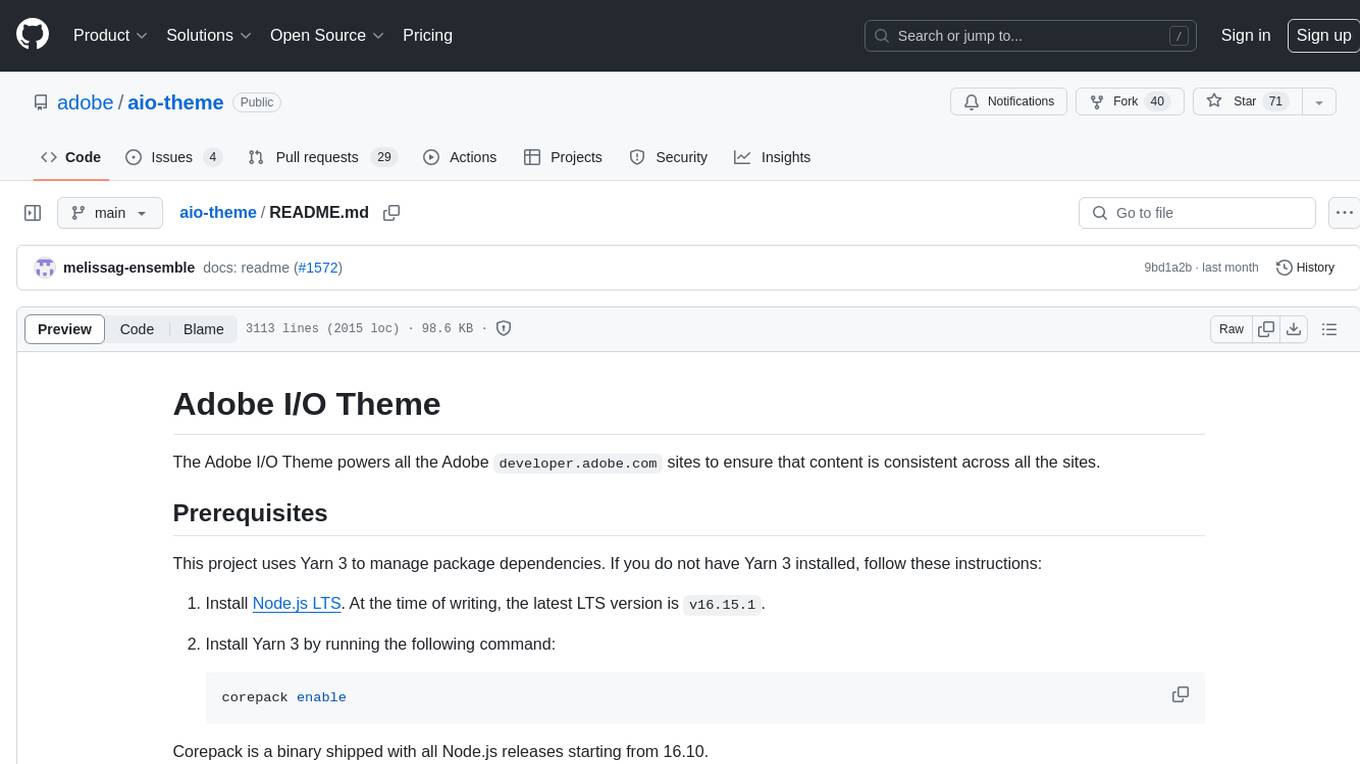
SpeziLLM
A module enabling the integration of Large Language Models (LLMs) with the Spezi Ecosystem
Stars: 131
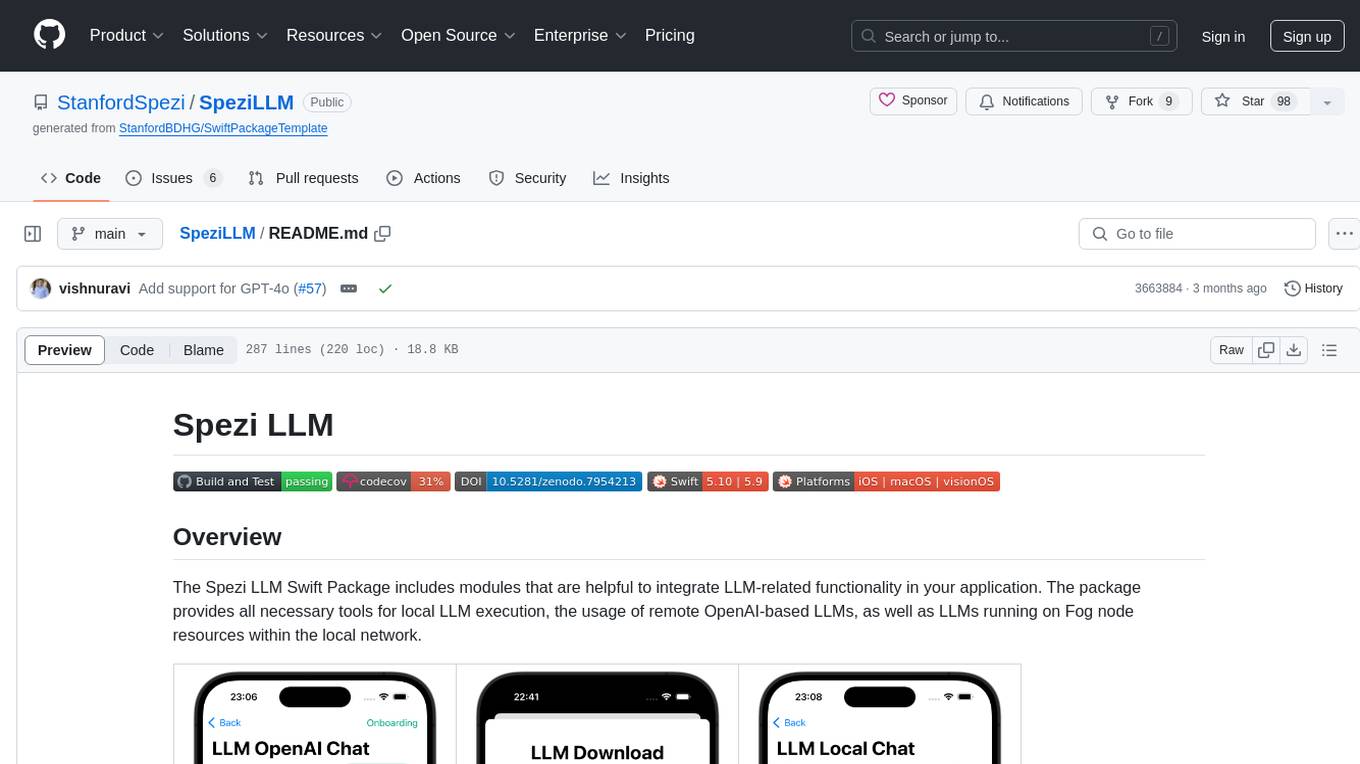
The Spezi LLM Swift Package includes modules that help integrate LLM-related functionality in applications. It provides tools for local LLM execution, usage of remote OpenAI-based LLMs, and LLMs running on Fog node resources within the local network. The package contains targets like SpeziLLM, SpeziLLMLocal, SpeziLLMLocalDownload, SpeziLLMOpenAI, and SpeziLLMFog for different LLM functionalities. Users can configure and interact with local LLMs, OpenAI LLMs, and Fog LLMs using the provided APIs and platforms within the Spezi ecosystem.
README:
The Spezi LLM Swift Package includes modules that are helpful to integrate LLM-related functionality in your application. The package provides all necessary tools for local LLM execution, the usage of remote OpenAI-based LLMs, as well as LLMs running on Fog node resources within the local network.
 |
 |
 |
|---|---|---|
OpenAI LLM Chat View |
Language Model Download |
Local LLM Chat View |
You need to add the SpeziLLM Swift package to your app in Xcode or Swift package.
[!IMPORTANT]
If your application is not yet configured to use Spezi, follow the Spezi setup article to set up the core Spezi infrastructure.
As Spezi LLM contains a variety of different targets for specific LLM functionalities, please follow the additional setup guide in the respective target section of this README.
Spezi LLM provides a number of targets to help developers integrate LLMs in their Spezi-based applications:
- SpeziLLM: Base infrastructure of LLM execution in the Spezi ecosystem.
- SpeziLLMLocal: Local LLM execution capabilities directly on-device. Enables running open-source LLMs like Meta's Llama2 models.
- SpeziLLMLocalDownload: Download and storage manager of local Language Models, including onboarding views.
- SpeziLLMOpenAI: Integration with OpenAI's GPT models via using OpenAI's API service.
- SpeziLLMFog: Discover and dispatch LLM inference jobs to Fog node resources within the local network.
The section below highlights the setup and basic use of the SpeziLLMLocal, SpeziLLMOpenAI, and SpeziLLMFog targets in order to integrate Language Models in a Spezi-based application.
[!NOTE]
To learn more about the usage of the individual targets, please refer to the DocC documentation of the package.
The target enables developers to easily execute medium-size Language Models (LLMs) locally on-device via the llama.cpp framework. The module allows you to interact with the locally run LLM via purely Swift-based APIs, no interaction with low-level C or C++ code is necessary, building on top of the infrastructure of the SpeziLLM target.
[!IMPORTANT] Important: In order to use the LLM local target, one needs to set build parameters in the consuming Xcode project or the consuming SPM package to enable the Swift / C++ Interop, introduced in Xcode 15 and Swift 5.9. Keep in mind that this is true for nested dependencies, one needs to set this configuration recursivly for the entire dependency tree towards the llama.cpp SPM package.
For Xcode projects:
- Open your build settings in Xcode by selecting PROJECT_NAME > TARGET_NAME > Build Settings.
- Within the Build Settings, search for the
C++ and Objective-C Interoperabilitysetting and set it toC++ / Objective-C++. This enables the project to use the C++ headers from llama.cpp.For SPM packages:
- Open the
Package.swiftfile of your SPM package- Within the package
targetthat consumes the llama.cpp package, add theinteroperabilityMode(_:)Swift build setting like that:/// Adds the dependency to the Spezi LLM SPM package dependencies: [ .package(url: "https://github.com/StanfordSpezi/SpeziLLM", .upToNextMinor(from: "0.6.0")) ], targets: [ .target( name: "ExampleConsumingTarget", /// State the dependence of the target to SpeziLLMLocal dependencies: [ .product(name: "SpeziLLMLocal", package: "SpeziLLM") ], /// Important: Configure the `.interoperabilityMode(_:)` within the `swiftSettings` swiftSettings: [ .interoperabilityMode(.Cxx) ] ) ]
You can configure the Spezi Local LLM execution within the typical SpeziAppDelegate.
In the example below, the LLMRunner from the SpeziLLM target which is responsible for providing LLM functionality within the Spezi ecosystem is configured with the LLMLocalPlatform from the SpeziLLMLocal target. This prepares the LLMRunner to locally execute Language Models.
class TestAppDelegate: SpeziAppDelegate {
override var configuration: Configuration {
Configuration {
LLMRunner {
LLMLocalPlatform()
}
}
}
}The code example below showcases the interaction with local LLMs through the the SpeziLLM LLMRunner, which is injected into the SwiftUI Environment via the Configuration shown above.
The LLMLocalSchema defines the type and configurations of the to-be-executed LLMLocalSession. This transformation is done via the LLMRunner that uses the LLMLocalPlatform. The inference via LLMLocalSession/generate() returns an AsyncThrowingStream that yields all generated String pieces.
struct LLMLocalDemoView: View {
@Environment(LLMRunner.self) var runner
@State var responseText = ""
var body: some View {
Text(responseText)
.task {
// Instantiate the `LLMLocalSchema` to an `LLMLocalSession` via the `LLMRunner`.
let llmSession: LLMLocalSession = runner(
with: LLMLocalSchema(
modelPath: URL(string: "URL to the local model file")!
)
)
do {
for try await token in try await llmSession.generate() {
responseText.append(token)
}
} catch {
// Handle errors here. E.g., you can use `ViewState` and `viewStateAlert` from SpeziViews.
}
}
}
}
[!NOTE]
To learn more about the usage of SpeziLLMLocal, please refer to the DocC documentation.
A module that allows you to interact with GPT-based Large Language Models (LLMs) from OpenAI within your Spezi application.
SpeziLLMOpenAI provides a pure Swift-based API for interacting with the OpenAI GPT API, building on top of the infrastructure of the SpeziLLM target.
In addition, SpeziLLMOpenAI provides developers with a declarative Domain Specific Language to utilize OpenAI function calling mechanism. This enables a structured, bidirectional, and reliable communication between the OpenAI LLMs and external tools, such as the Spezi ecosystem.
In order to use OpenAI LLMs within the Spezi ecosystem, the SpeziLLM LLMRunner needs to be initialized in the Spezi Configuration with the LLMOpenAIPlatform. Only after, the LLMRunner can be used for inference of OpenAI LLMs.
See the SpeziLLM documentation for more details.
import Spezi
import SpeziLLM
import SpeziLLMOpenAI
class LLMOpenAIAppDelegate: SpeziAppDelegate {
override var configuration: Configuration {
Configuration {
LLMRunner {
LLMOpenAIPlatform()
}
}
}
}[!IMPORTANT] If using
SpeziLLMOpenAIon macOS, ensure to add theKeychain Access Groupsentitlement to the enclosing Xcode project via PROJECT_NAME > Signing&Capabilities > + Capability. The array of keychain groups can be left empty, only the base entitlement is required.
The code example below showcases the interaction with an OpenAI LLM through the the SpeziLLM LLMRunner, which is injected into the SwiftUI Environment via the Configuration shown above.
The LLMOpenAISchema defines the type and configurations of the to-be-executed LLMOpenAISession. This transformation is done via the LLMRunner that uses the LLMOpenAIPlatform. The inference via LLMOpenAISession/generate() returns an AsyncThrowingStream that yields all generated String pieces.
import SpeziLLM
import SpeziLLMOpenAI
import SwiftUI
struct LLMOpenAIDemoView: View {
@Environment(LLMRunner.self) var runner
@State var responseText = ""
var body: some View {
Text(responseText)
.task {
// Instantiate the `LLMOpenAISchema` to an `LLMOpenAISession` via the `LLMRunner`.
let llmSession: LLMOpenAISession = runner(
with: LLMOpenAISchema(
parameters: .init(
modelType: .gpt3_5Turbo,
systemPrompt: "You're a helpful assistant that answers questions from users.",
overwritingToken: "abc123"
)
)
)
do {
for try await token in try await llmSession.generate() {
responseText.append(token)
}
} catch {
// Handle errors here. E.g., you can use `ViewState` and `viewStateAlert` from SpeziViews.
}
}
}
}
[!NOTE]
To learn more about the usage of SpeziLLMOpenAI, please refer to the DocC documentation.
The SpeziLLMFog target enables you to use LLMs running on Fog node computing resources within the local network. The fog nodes advertise their services via mDNS, enabling clients to discover all fog nodes serving a specific host within the local network.
SpeziLLMFog then dispatches LLM inference jobs dynamically to a random fog node within the local network and streams the response to surface it to the user.
[!IMPORTANT]
SpeziLLMFogrequires aSpeziLLMFogNodewithin the local network hosted on some computing resource that actually performs the inference requests.SpeziLLMFogprovides theSpeziLLMFogNodeDocker-based package that enables an easy setup of these fog nodes. See theFogNodedirectory on the root level of the SPM package as well as the respectiveREADME.mdfor more details.
In order to use Fog LLMs within the Spezi ecosystem, the SpeziLLM LLMRunner needs to be initialized in the Spezi Configuration with the LLMFogPlatform. Only after, the LLMRunner can be used for inference with Fog LLMs. See the SpeziLLM documentation for more details.
The LLMFogPlatform needs to be initialized with the custom root CA certificate that was used to sign the fog node web service certificate (see the FogNode/README.md documentation for more information). Copy the root CA certificate from the fog node as resource to the application using SpeziLLMFog and use it to initialize the LLMFogPlatform within the Spezi Configuration.
class LLMFogAppDelegate: SpeziAppDelegate {
private nonisolated static var caCertificateUrl: URL {
// Return local file URL of root CA certificate in the `.crt` format
}
override var configuration: Configuration {
Configuration {
LLMRunner {
// Set up the Fog platform with the custom CA certificate
LLMRunner {
LLMFogPlatform(configuration: .init(caCertificate: Self.caCertificateUrl))
}
}
}
}
}The code example below showcases the interaction with a Fog LLM through the the SpeziLLM LLMRunner, which is injected into the SwiftUI Environment via the Configuration shown above.
The LLMFogSchema defines the type and configurations of the to-be-executed LLMFogSession. This transformation is done via the LLMRunner that uses the LLMFogPlatform. The inference via LLMFogSession/generate() returns an AsyncThrowingStream that yields all generated String pieces.
The LLMFogSession automatically discovers all available LLM fog nodes within the local network upon setup and the dispatches the LLM inference jobs to the fog computing resource, streaming back the response and surfaces it to the user.
[!IMPORTANT]
TheLLMFogSchemaaccepts a closure that returns an authorization token that is passed with every request to the Fog node in theBearerHTTP field via theLLMFogParameters/init(modelType:systemPrompt:authToken:). The token is created via the closure upon every LLM inference request, as theLLMFogSessionmay be long lasting and the token could therefore expire. Ensure that the closure appropriately caches the token in order to prevent unnecessary token refresh roundtrips to external systems.
struct LLMFogDemoView: View {
@Environment(LLMRunner.self) var runner
@State var responseText = ""
var body: some View {
Text(responseText)
.task {
// Instantiate the `LLMFogSchema` to an `LLMFogSession` via the `LLMRunner`.
let llmSession: LLMFogSession = runner(
with: LLMFogSchema(
parameters: .init(
modelType: .llama7B,
systemPrompt: "You're a helpful assistant that answers questions from users.",
authToken: {
// Return authorization token as `String` or `nil` if no token is required by the Fog node.
}
)
)
)
do {
for try await token in try await llmSession.generate() {
responseText.append(token)
}
} catch {
// Handle errors here. E.g., you can use `ViewState` and `viewStateAlert` from SpeziViews.
}
}
}
}
[!NOTE]
To learn more about the usage of SpeziLLMFog, please refer to the DocC documentation.
Contributions to this project are welcome. Please make sure to read the contribution guidelines and the contributor covenant code of conduct first.
This project is licensed under the MIT License. See Licenses for more information.
For Tasks:
Click tags to check more tools for each tasksFor Jobs:
Alternative AI tools for SpeziLLM
Similar Open Source Tools

SpeziLLM
The Spezi LLM Swift Package includes modules that help integrate LLM-related functionality in applications. It provides tools for local LLM execution, usage of remote OpenAI-based LLMs, and LLMs running on Fog node resources within the local network. The package contains targets like SpeziLLM, SpeziLLMLocal, SpeziLLMLocalDownload, SpeziLLMOpenAI, and SpeziLLMFog for different LLM functionalities. Users can configure and interact with local LLMs, OpenAI LLMs, and Fog LLMs using the provided APIs and platforms within the Spezi ecosystem.
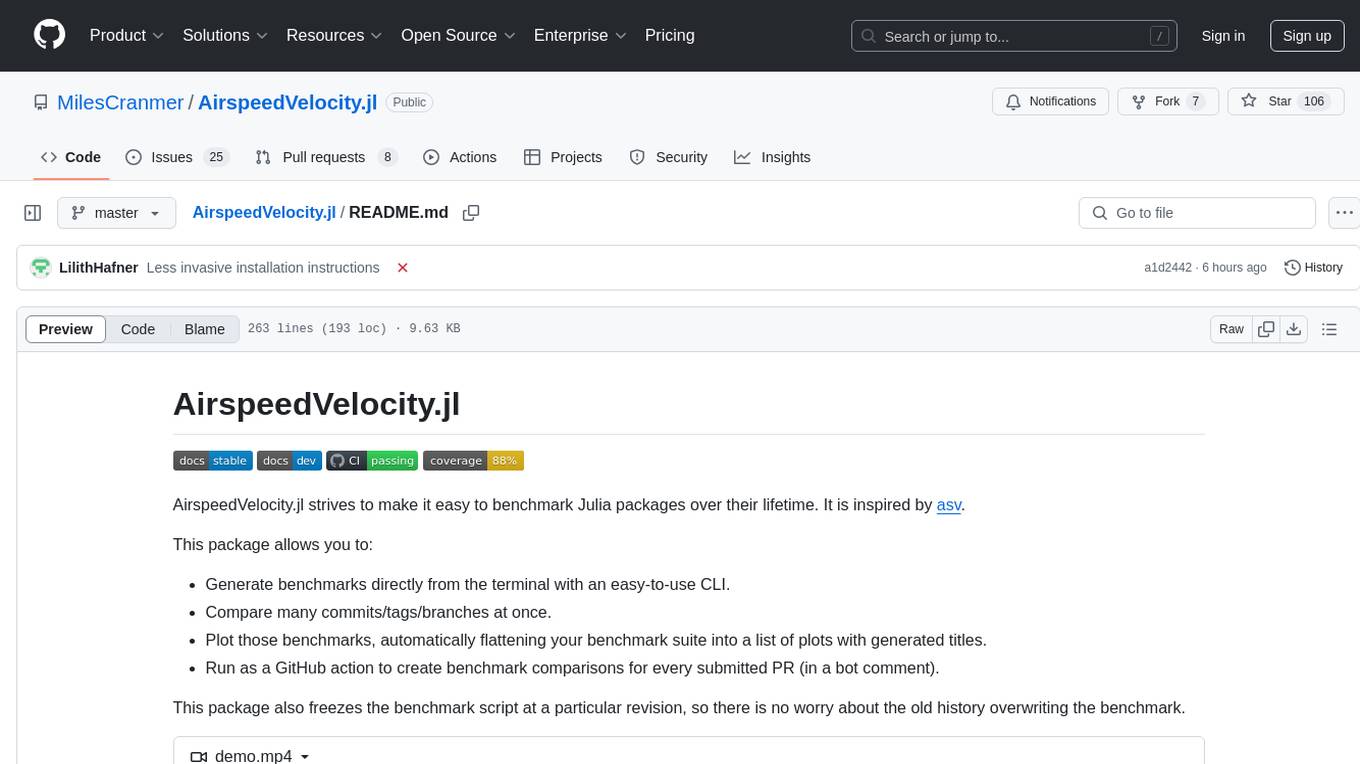
AirspeedVelocity.jl
AirspeedVelocity.jl is a tool designed to simplify benchmarking of Julia packages over their lifetime. It provides a CLI to generate benchmarks, compare commits/tags/branches, plot benchmarks, and run benchmark comparisons for every submitted PR as a GitHub action. The tool freezes the benchmark script at a specific revision to prevent old history from affecting benchmarks. Users can configure options using CLI flags and visualize benchmark results. AirspeedVelocity.jl can be used to benchmark any Julia package and offers features like generating tables and plots of benchmark results. It also supports custom benchmarks and can be integrated into GitHub actions for automated benchmarking of PRs.
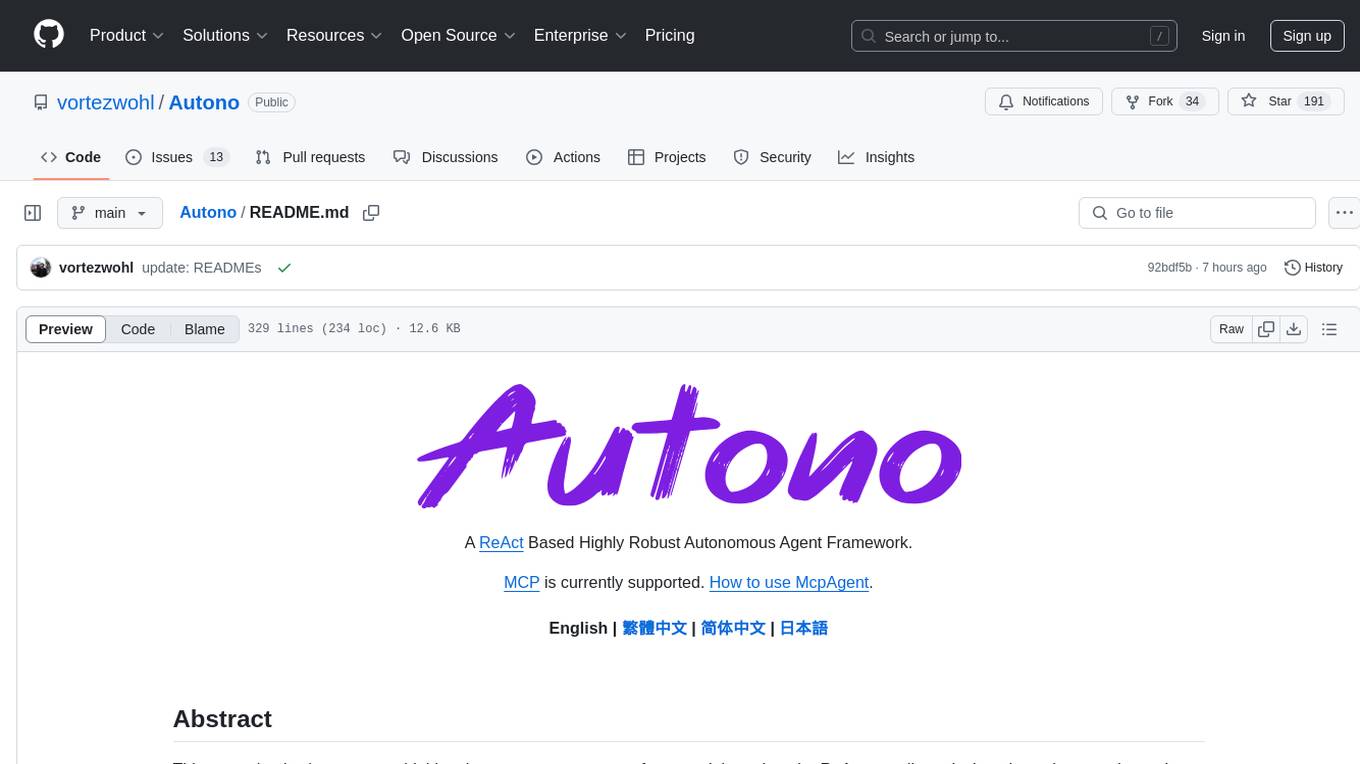
Autono
A highly robust autonomous agent framework based on the ReAct paradigm, designed for adaptive decision making and multi-agent collaboration. It dynamically generates next actions during agent execution, enhancing robustness. Features a timely abandonment strategy and memory transfer mechanism for multi-agent collaboration. The framework allows developers to balance conservative and exploratory tendencies in agent execution strategies, improving adaptability and task execution efficiency in complex environments. Supports external tool integration, modular design, and MCP protocol compatibility for flexible action space expansion. Multi-agent collaboration mechanism enables agents to focus on specific task components, improving execution efficiency and quality.
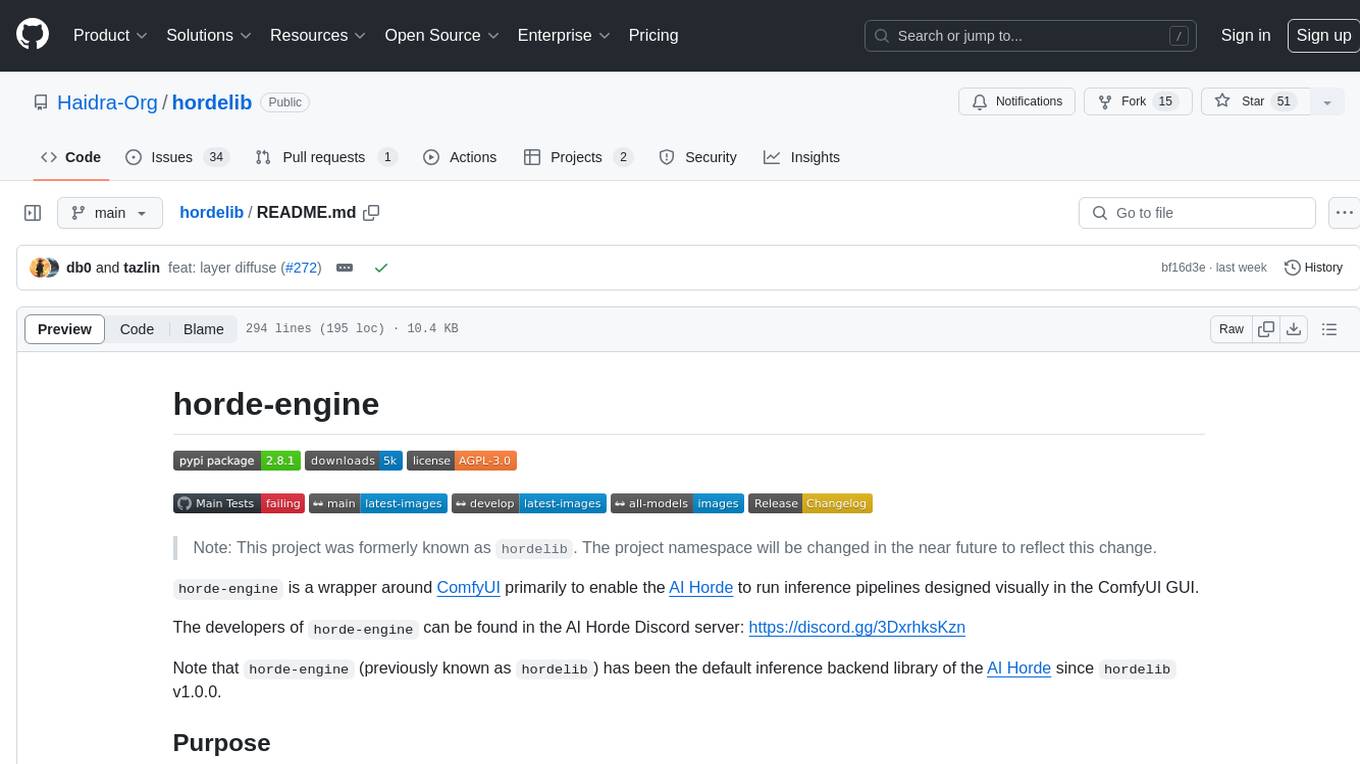
hordelib
horde-engine is a wrapper around ComfyUI designed to run inference pipelines visually designed in the ComfyUI GUI. It enables users to design inference pipelines in ComfyUI and then call them programmatically, maintaining compatibility with the existing horde implementation. The library provides features for processing Horde payloads, initializing the library, downloading and validating models, and generating images based on input data. It also includes custom nodes for preprocessing and tasks such as face restoration and QR code generation. The project depends on various open source projects and bundles some dependencies within the library itself. Users can design ComfyUI pipelines, convert them to the backend format, and run them using the run_image_pipeline() method in hordelib.comfy.Comfy(). The project is actively developed and tested using git, tox, and a specific model directory structure.
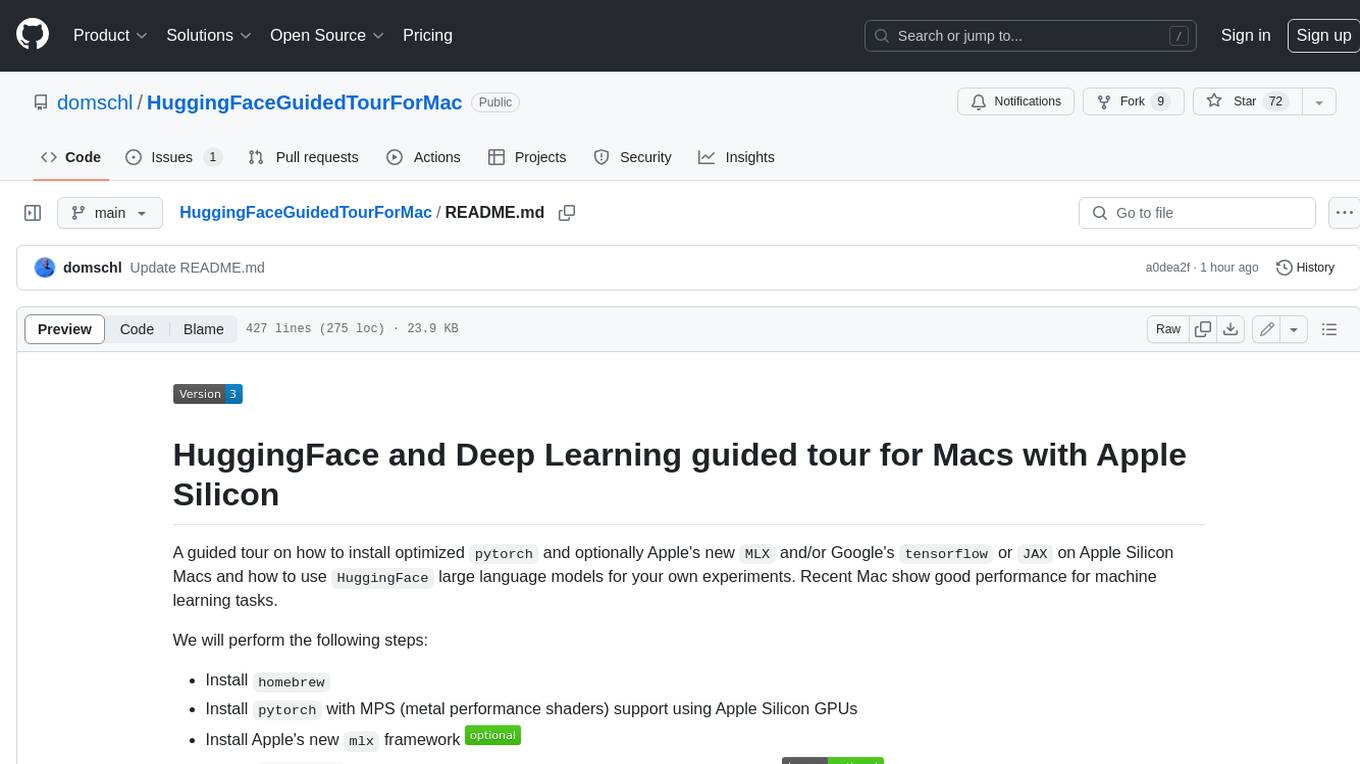
HuggingFaceGuidedTourForMac
HuggingFaceGuidedTourForMac is a guided tour on how to install optimized pytorch and optionally Apple's new MLX, JAX, and TensorFlow on Apple Silicon Macs. The repository provides steps to install homebrew, pytorch with MPS support, MLX, JAX, TensorFlow, and Jupyter lab. It also includes instructions on running large language models using HuggingFace transformers. The repository aims to help users set up their Macs for deep learning experiments with optimized performance.
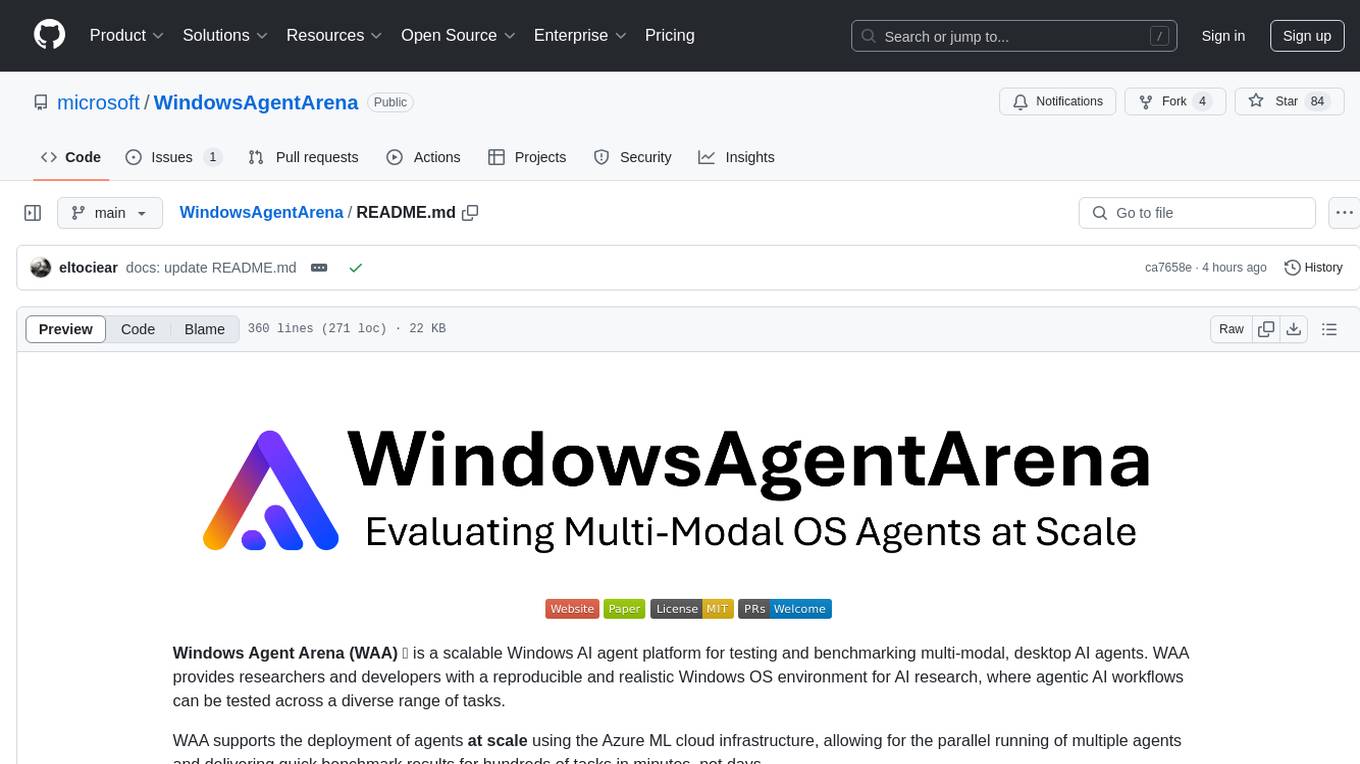
WindowsAgentArena
Windows Agent Arena (WAA) is a scalable Windows AI agent platform designed for testing and benchmarking multi-modal, desktop AI agents. It provides researchers and developers with a reproducible and realistic Windows OS environment for AI research, enabling testing of agentic AI workflows across various tasks. WAA supports deploying agents at scale using Azure ML cloud infrastructure, allowing parallel running of multiple agents and delivering quick benchmark results for hundreds of tasks in minutes.
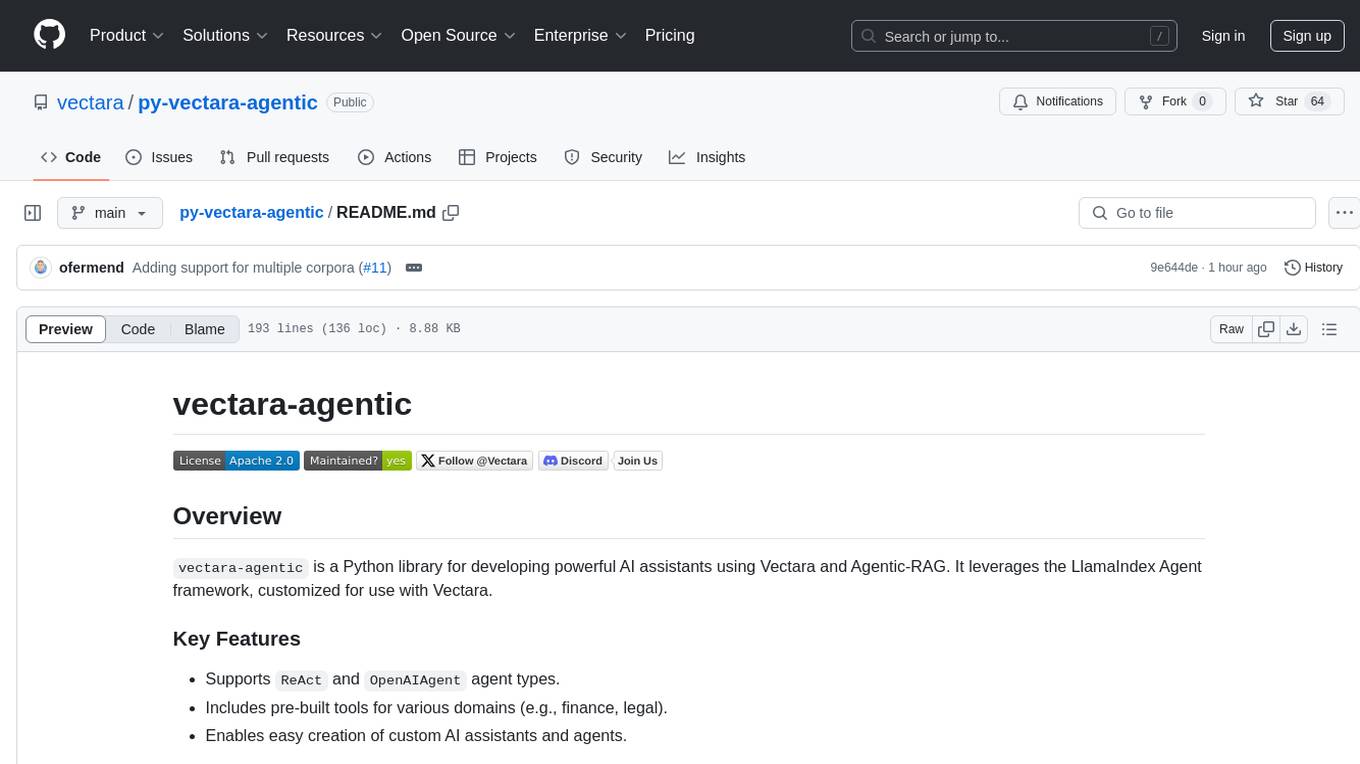
py-vectara-agentic
The `vectara-agentic` Python library is designed for developing powerful AI assistants using Vectara and Agentic-RAG. It supports various agent types, includes pre-built tools for domains like finance and legal, and enables easy creation of custom AI assistants and agents. The library provides tools for summarizing text, rephrasing text, legal tasks like summarizing legal text and critiquing as a judge, financial tasks like analyzing balance sheets and income statements, and database tools for inspecting and querying databases. It also supports observability via LlamaIndex and Arize Phoenix integration.
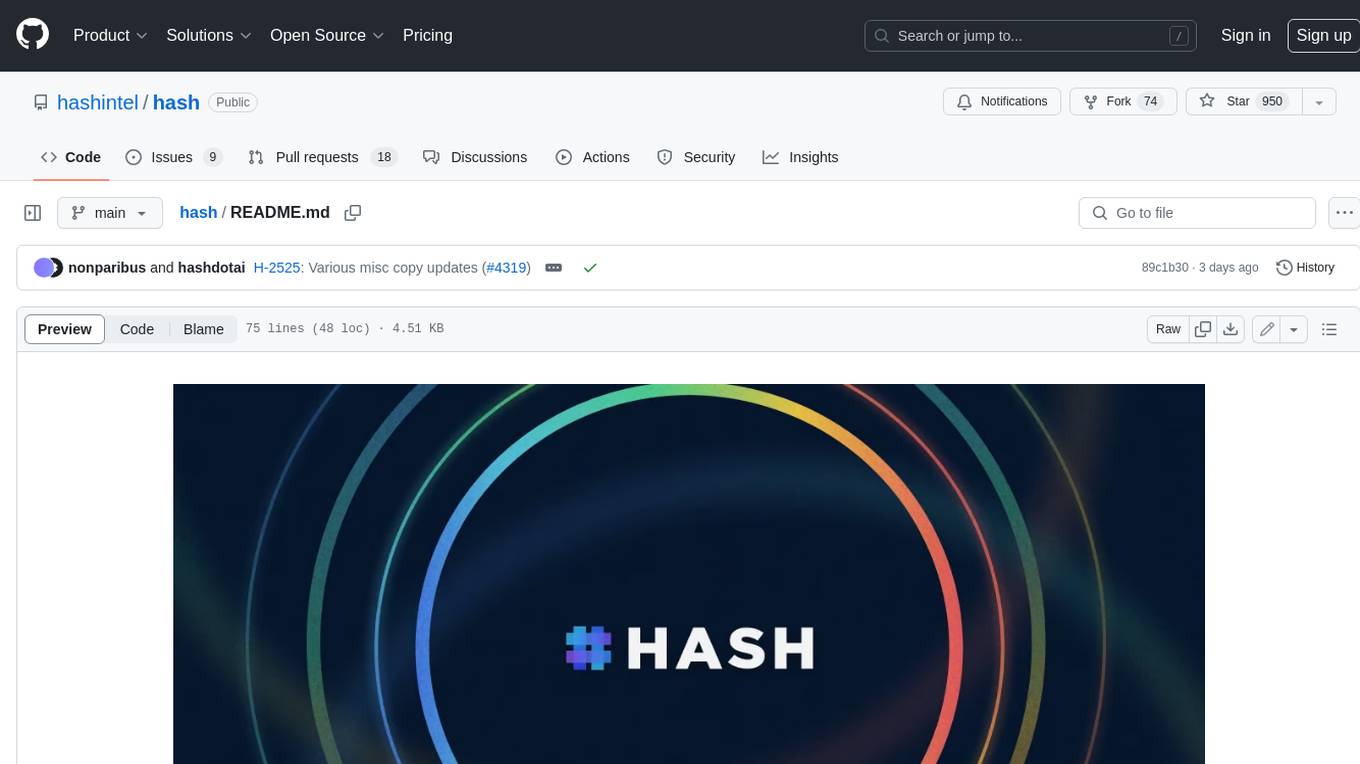
hash
HASH is a self-building, open-source database which grows, structures and checks itself. With it, we're creating a platform for decision-making, which helps you integrate, understand and use data in a variety of different ways.
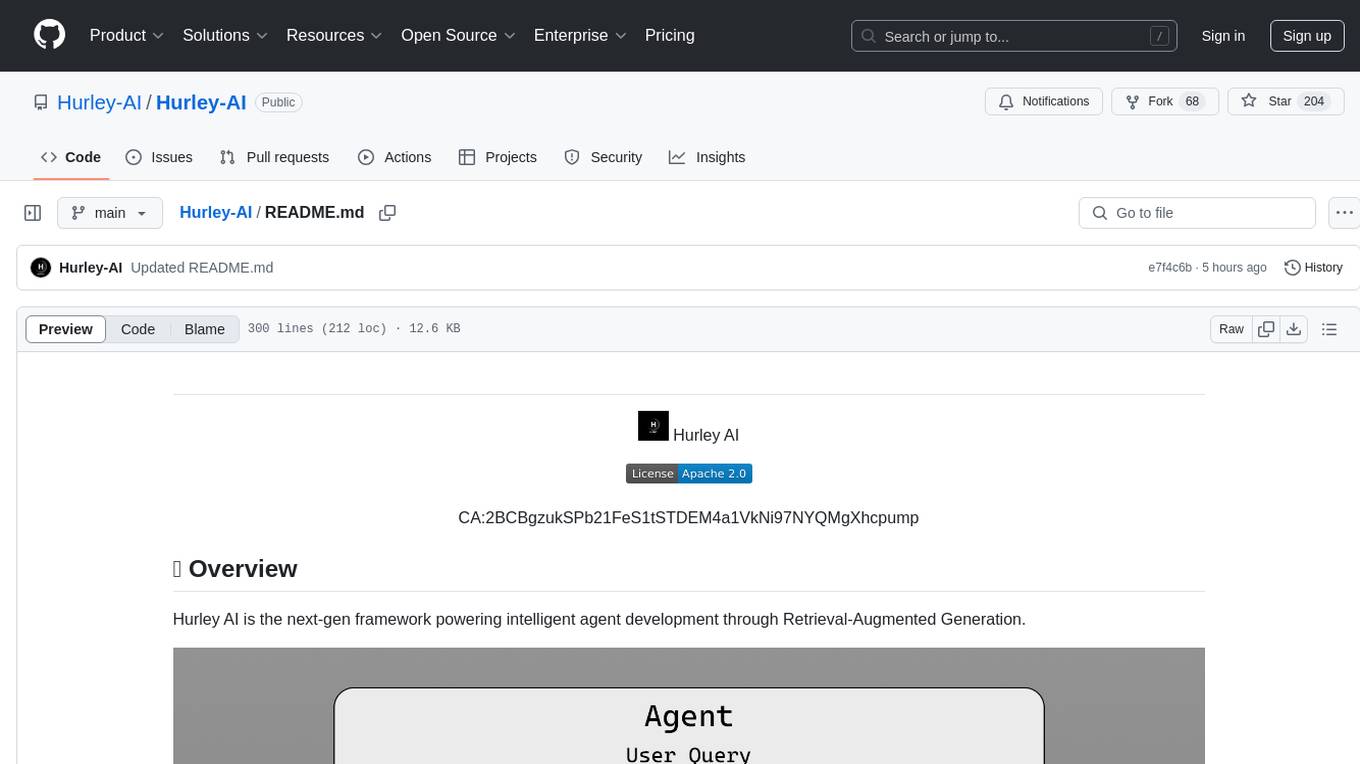
Hurley-AI
Hurley AI is a next-gen framework for developing intelligent agents through Retrieval-Augmented Generation. It enables easy creation of custom AI assistants and agents, supports various agent types, and includes pre-built tools for domains like finance and legal. Hurley AI integrates with LLM inference services and provides observability with Arize Phoenix. Users can create Hurley RAG tools with a single line of code and customize agents with specific instructions. The tool also offers various helper functions to connect with Hurley RAG and search tools, along with pre-built tools for tasks like summarizing text, rephrasing text, understanding memecoins, and querying databases.
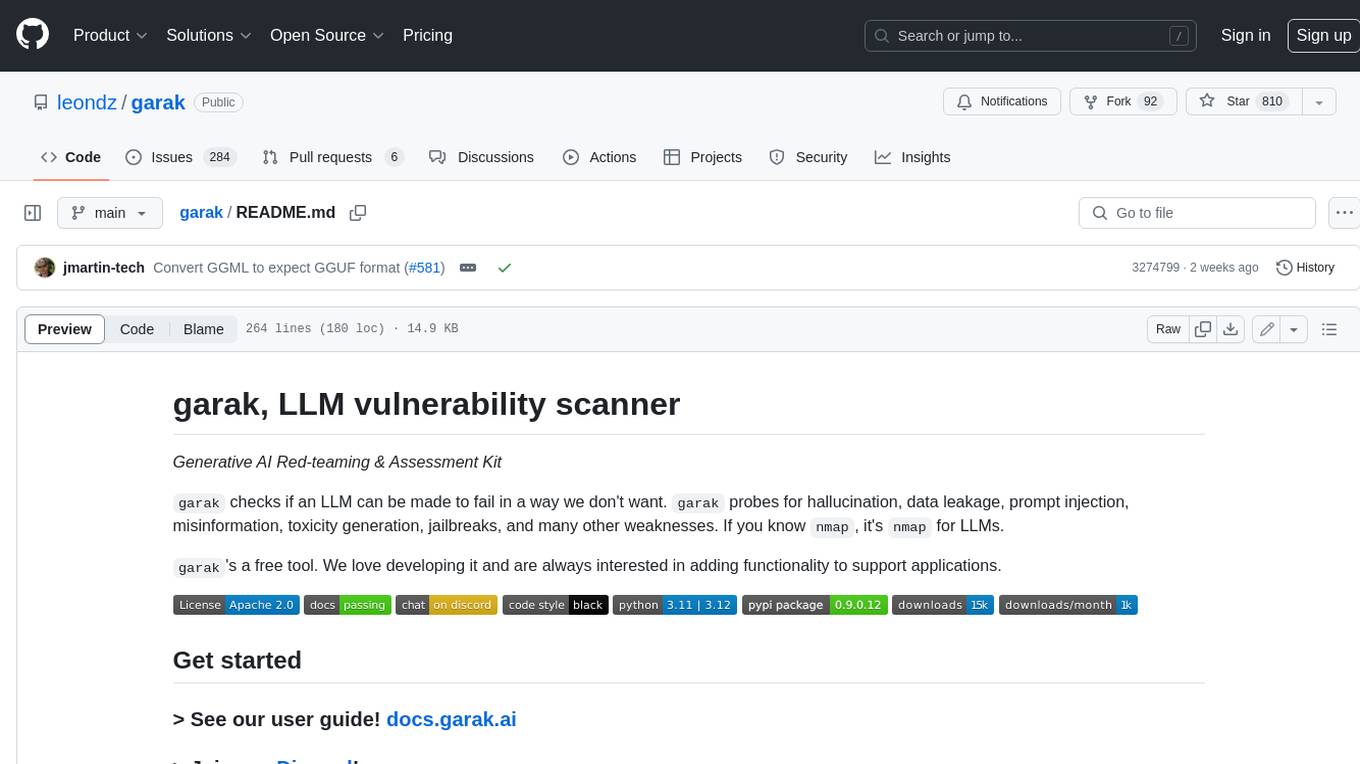
garak
Garak is a free tool that checks if a Large Language Model (LLM) can be made to fail in a way that is undesirable. It probes for hallucination, data leakage, prompt injection, misinformation, toxicity generation, jailbreaks, and many other weaknesses. Garak's a free tool. We love developing it and are always interested in adding functionality to support applications.
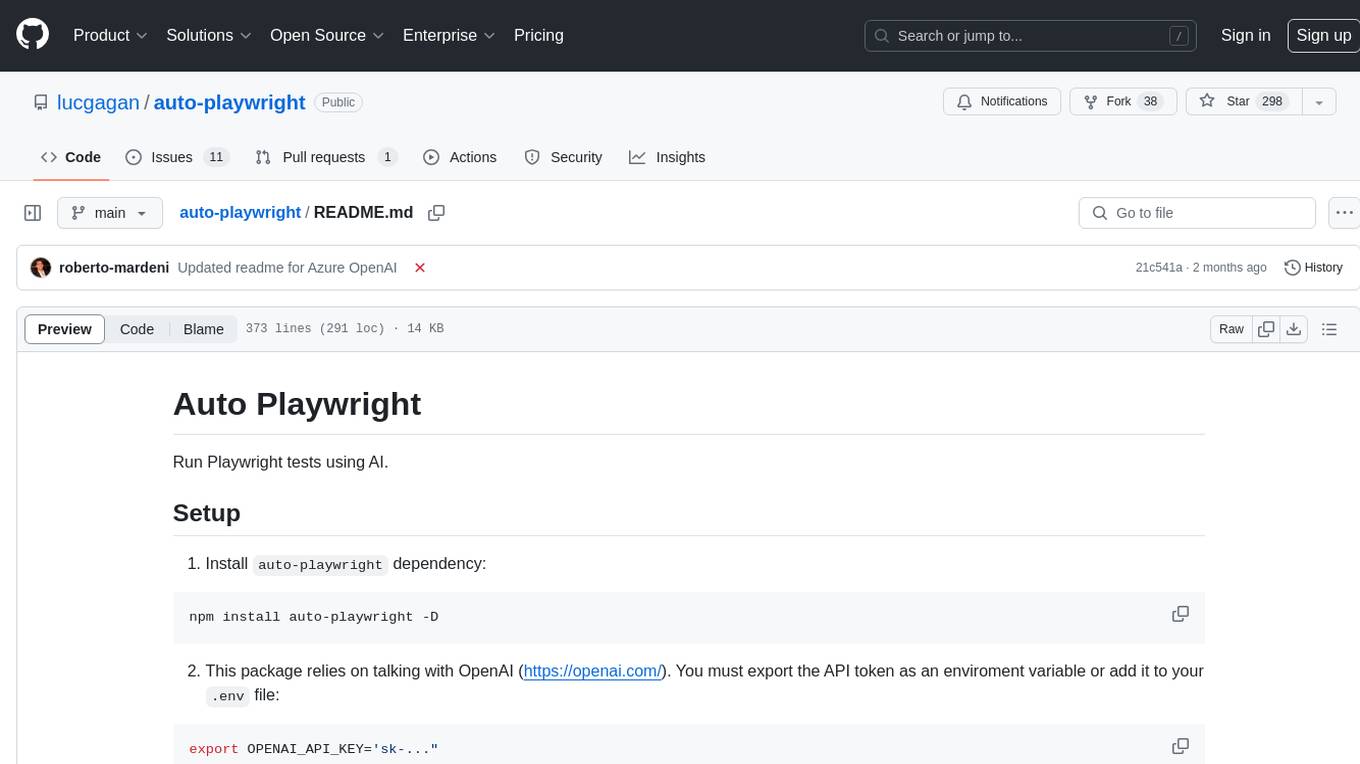
auto-playwright
Auto Playwright is a tool that allows users to run Playwright tests using AI. It eliminates the need for selectors by determining actions at runtime based on plain-text instructions. Users can automate complex scenarios, write tests concurrently with or before functionality development, and benefit from rapid test creation. The tool supports various Playwright actions and offers additional options for debugging and customization. It uses HTML sanitization to reduce costs and improve text quality when interacting with the OpenAI API.
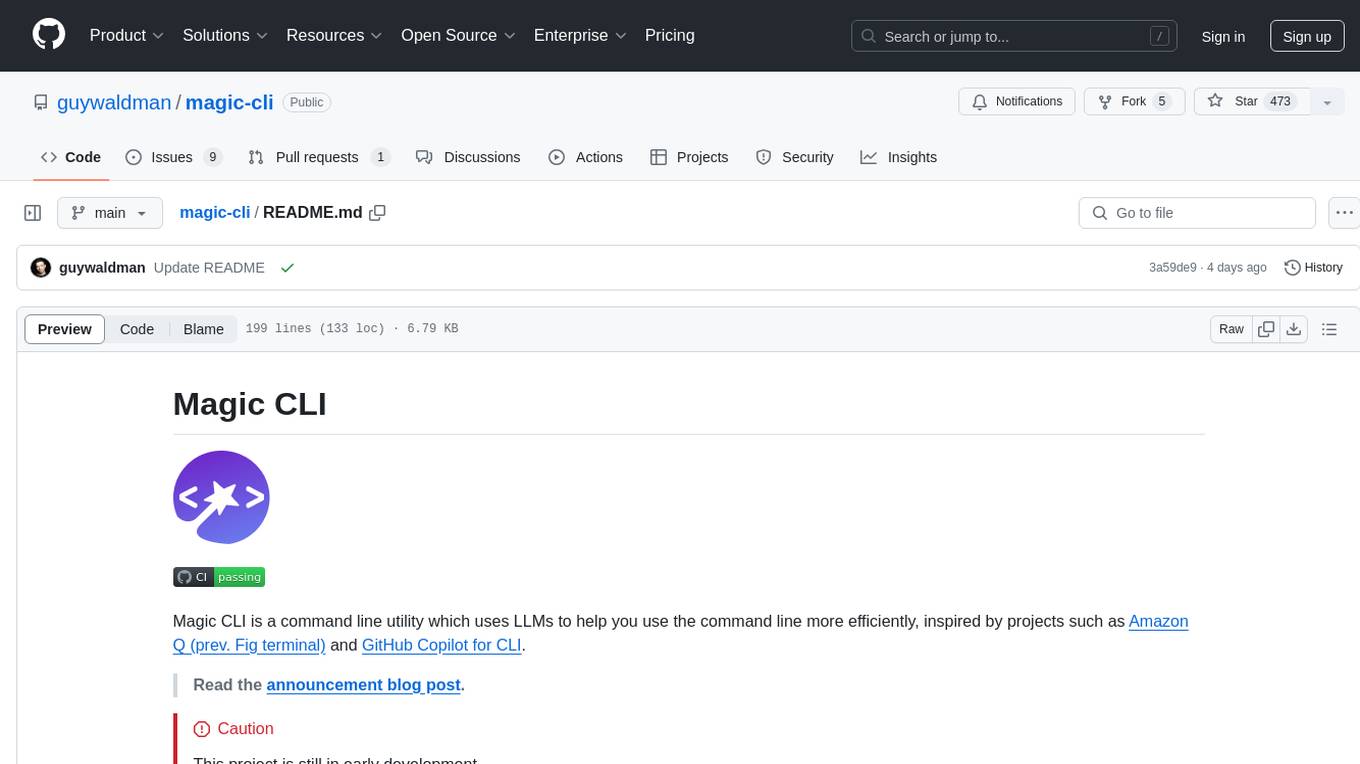
magic-cli
Magic CLI is a command line utility that leverages Large Language Models (LLMs) to enhance command line efficiency. It is inspired by projects like Amazon Q and GitHub Copilot for CLI. The tool allows users to suggest commands, search across command history, and generate commands for specific tasks using local or remote LLM providers. Magic CLI also provides configuration options for LLM selection and response generation. The project is still in early development, so users should expect breaking changes and bugs.
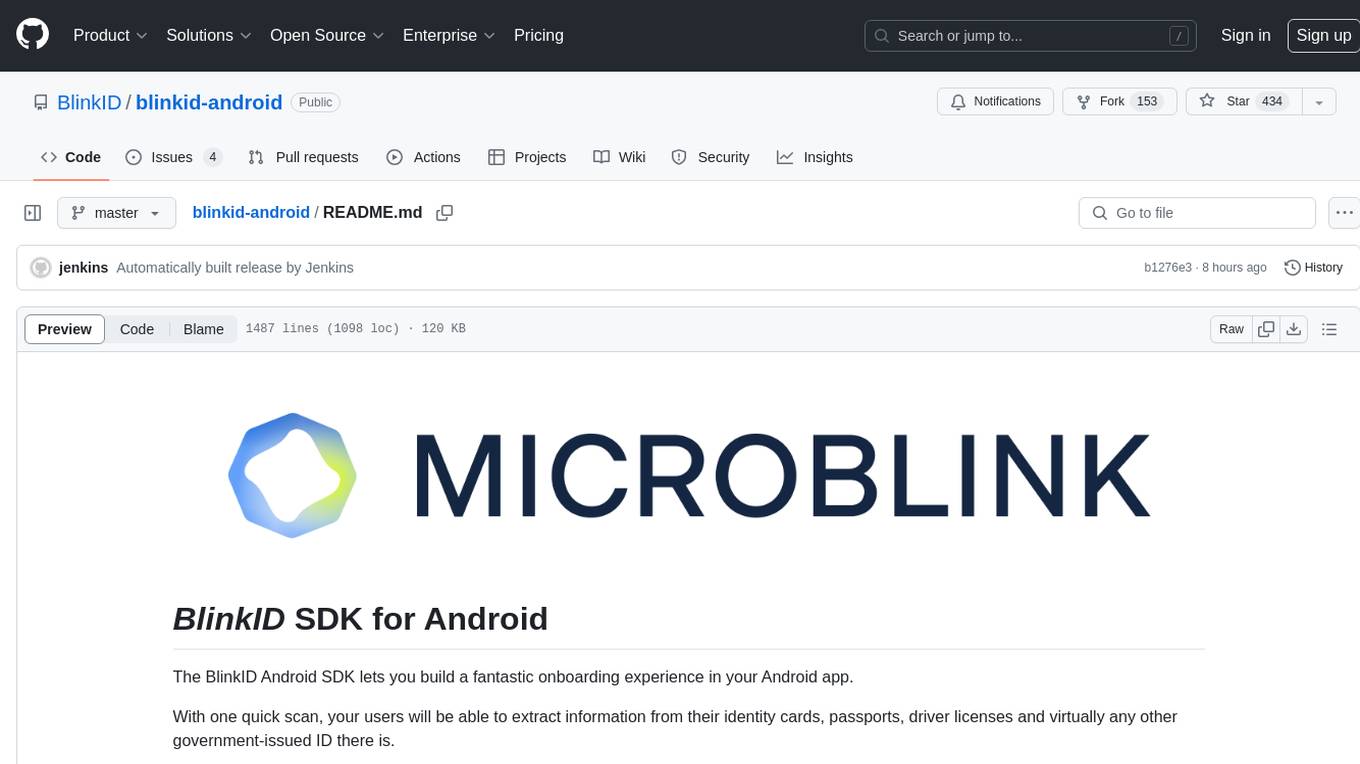
blinkid-android
The BlinkID Android SDK is a comprehensive solution for implementing secure document scanning and extraction. It offers powerful capabilities for extracting data from a wide range of identification documents. The SDK provides features for integrating document scanning into Android apps, including camera requirements, SDK resource pre-bundling, customizing the UX, changing default strings and localization, troubleshooting integration difficulties, and using the SDK through various methods. It also offers options for completely custom UX with low-level API integration. The SDK size is optimized for different processor architectures, and API documentation is available for reference. For any questions or support, users can contact the Microblink team at help.microblink.com.
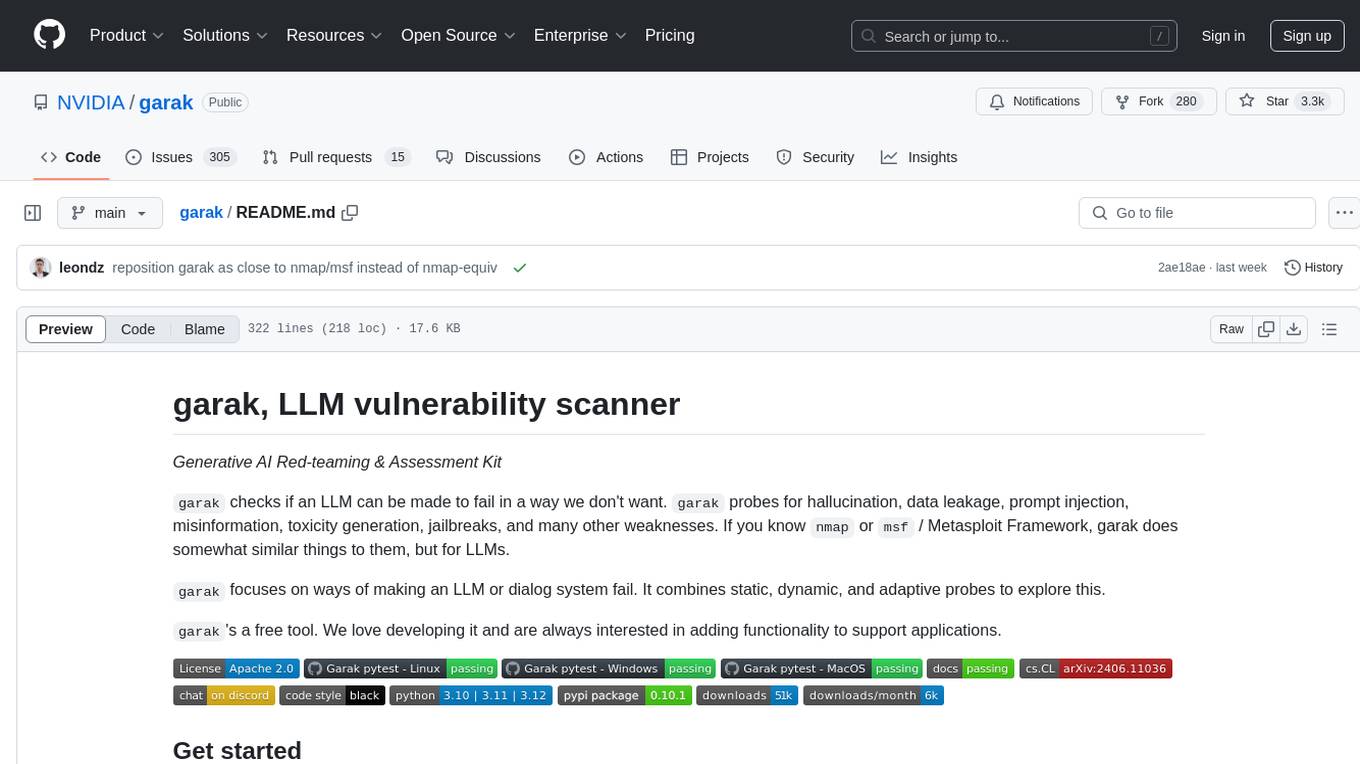
garak
Garak is a vulnerability scanner designed for LLMs (Large Language Models) that checks for various weaknesses such as hallucination, data leakage, prompt injection, misinformation, toxicity generation, and jailbreaks. It combines static, dynamic, and adaptive probes to explore vulnerabilities in LLMs. Garak is a free tool developed for red-teaming and assessment purposes, focusing on making LLMs or dialog systems fail. It supports various LLM models and can be used to assess their security and robustness.
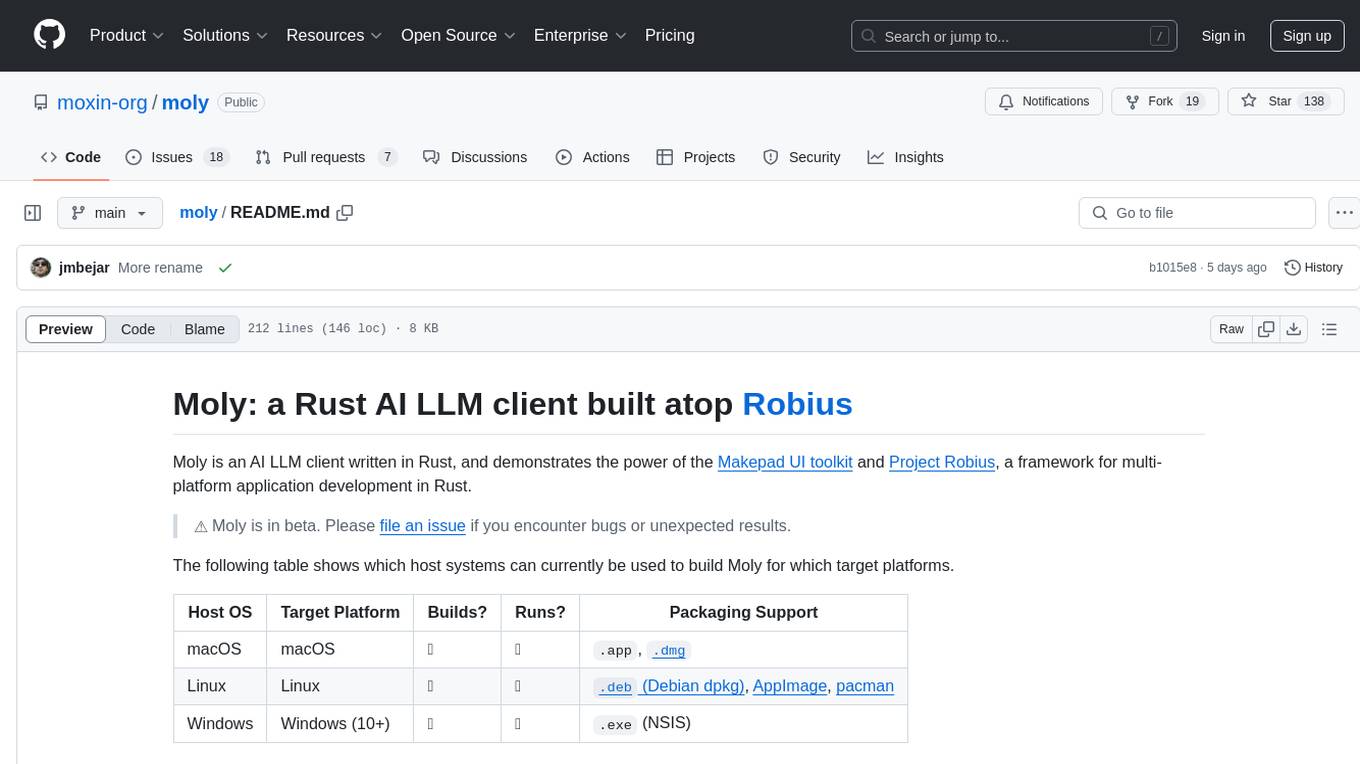
moly
Moly is an AI LLM client written in Rust, showcasing the capabilities of the Makepad UI toolkit and Project Robius, a framework for multi-platform application development in Rust. It is currently in beta, allowing users to build and run Moly on macOS, Linux, and Windows. The tool provides packaging support for different platforms, such as `.app`, `.dmg`, `.deb`, AppImage, pacman, and `.exe` (NSIS). Users can easily set up WasmEdge using `moly-runner` and leverage `cargo` commands to build and run Moly. Additionally, Moly offers pre-built releases for download and supports packaging for distribution on Linux, Windows, and macOS.
For similar tasks

SpeziLLM
The Spezi LLM Swift Package includes modules that help integrate LLM-related functionality in applications. It provides tools for local LLM execution, usage of remote OpenAI-based LLMs, and LLMs running on Fog node resources within the local network. The package contains targets like SpeziLLM, SpeziLLMLocal, SpeziLLMLocalDownload, SpeziLLMOpenAI, and SpeziLLMFog for different LLM functionalities. Users can configure and interact with local LLMs, OpenAI LLMs, and Fog LLMs using the provided APIs and platforms within the Spezi ecosystem.
For similar jobs

weave
Weave is a toolkit for developing Generative AI applications, built by Weights & Biases. With Weave, you can log and debug language model inputs, outputs, and traces; build rigorous, apples-to-apples evaluations for language model use cases; and organize all the information generated across the LLM workflow, from experimentation to evaluations to production. Weave aims to bring rigor, best-practices, and composability to the inherently experimental process of developing Generative AI software, without introducing cognitive overhead.

LLMStack
LLMStack is a no-code platform for building generative AI agents, workflows, and chatbots. It allows users to connect their own data, internal tools, and GPT-powered models without any coding experience. LLMStack can be deployed to the cloud or on-premise and can be accessed via HTTP API or triggered from Slack or Discord.

VisionCraft
The VisionCraft API is a free API for using over 100 different AI models. From images to sound.

kaito
Kaito is an operator that automates the AI/ML inference model deployment in a Kubernetes cluster. It manages large model files using container images, avoids tuning deployment parameters to fit GPU hardware by providing preset configurations, auto-provisions GPU nodes based on model requirements, and hosts large model images in the public Microsoft Container Registry (MCR) if the license allows. Using Kaito, the workflow of onboarding large AI inference models in Kubernetes is largely simplified.

PyRIT
PyRIT is an open access automation framework designed to empower security professionals and ML engineers to red team foundation models and their applications. It automates AI Red Teaming tasks to allow operators to focus on more complicated and time-consuming tasks and can also identify security harms such as misuse (e.g., malware generation, jailbreaking), and privacy harms (e.g., identity theft). The goal is to allow researchers to have a baseline of how well their model and entire inference pipeline is doing against different harm categories and to be able to compare that baseline to future iterations of their model. This allows them to have empirical data on how well their model is doing today, and detect any degradation of performance based on future improvements.

tabby
Tabby is a self-hosted AI coding assistant, offering an open-source and on-premises alternative to GitHub Copilot. It boasts several key features: * Self-contained, with no need for a DBMS or cloud service. * OpenAPI interface, easy to integrate with existing infrastructure (e.g Cloud IDE). * Supports consumer-grade GPUs.

spear
SPEAR (Simulator for Photorealistic Embodied AI Research) is a powerful tool for training embodied agents. It features 300 unique virtual indoor environments with 2,566 unique rooms and 17,234 unique objects that can be manipulated individually. Each environment is designed by a professional artist and features detailed geometry, photorealistic materials, and a unique floor plan and object layout. SPEAR is implemented as Unreal Engine assets and provides an OpenAI Gym interface for interacting with the environments via Python.

Magick
Magick is a groundbreaking visual AIDE (Artificial Intelligence Development Environment) for no-code data pipelines and multimodal agents. Magick can connect to other services and comes with nodes and templates well-suited for intelligent agents, chatbots, complex reasoning systems and realistic characters.




